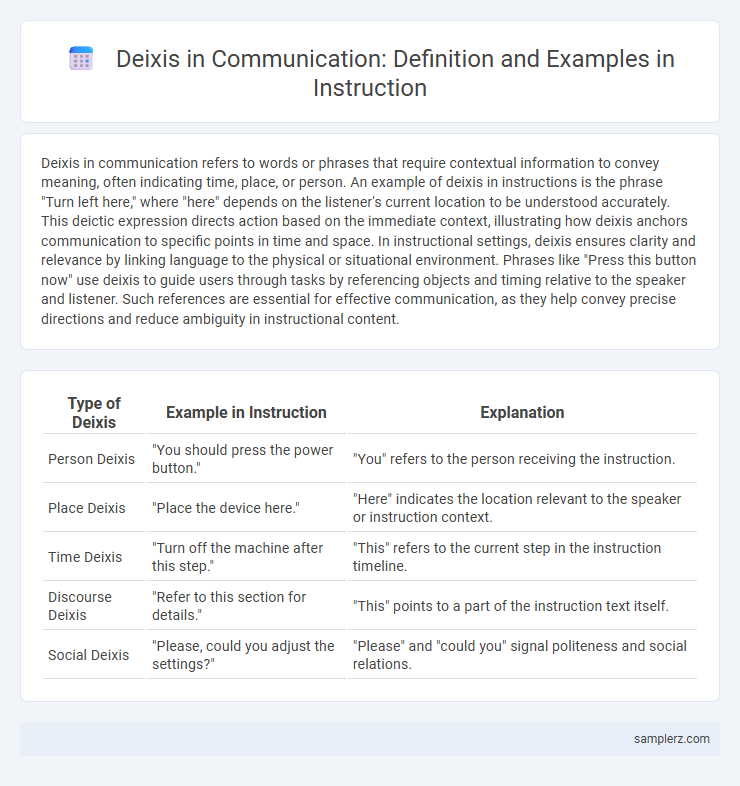Deixis in communication refers to words or phrases that require contextual information to convey meaning, often indicating time, place, or person. An example of deixis in instructions is the phrase "Turn left here," where "here" depends on the listener's current location to be understood accurately. This deictic expression directs action based on the immediate context, illustrating how deixis anchors communication to specific points in time and space. In instructional settings, deixis ensures clarity and relevance by linking language to the physical or situational environment. Phrases like "Press this button now" use deixis to guide users through tasks by referencing objects and timing relative to the speaker and listener. Such references are essential for effective communication, as they help convey precise directions and reduce ambiguity in instructional content.
Table of Comparison
| Type of Deixis | Example in Instruction | Explanation |
|---|---|---|
| Person Deixis | "You should press the power button." | "You" refers to the person receiving the instruction. |
| Place Deixis | "Place the device here." | "Here" indicates the location relevant to the speaker or instruction context. |
| Time Deixis | "Turn off the machine after this step." | "This" refers to the current step in the instruction timeline. |
| Discourse Deixis | "Refer to this section for details." | "This" points to a part of the instruction text itself. |
| Social Deixis | "Please, could you adjust the settings?" | "Please" and "could you" signal politeness and social relations. |
Understanding Deixis in Instructional Communication
Understanding deixis in instructional communication enhances clarity by anchoring references to time, place, and participants. For example, the instruction "Turn to page 5 in your textbook" uses spatial deixis to direct learners' attention within their immediate environment. Temporal deixis appears in phrases like "complete the exercise tomorrow," situating tasks within a specific timeframe that learners can easily interpret.
Types of Deictic Expressions in Classroom Language
In classroom language, deixis appears in various types, such as personal deixis with pronouns like "you" and "we" to indicate participants in the communication. Temporal deixis involves expressions like "now" or "later" to reference time events relevant to the lesson. Spatial deixis uses terms like "here" and "there" to direct student attention to specific physical locations or objects in the learning environment.
Person Deixis: Addressing Learners Directly
Person deixis in instructional communication is evident when teachers use pronouns like "you" to directly engage learners, creating a personalized learning experience. Phrases such as "You need to complete this task" or "Can you identify the main idea?" explicitly position the learner within the instructional context, enhancing clarity and focus. This direct address helps maintain learner attention and encourages active participation by establishing a clear interlocutor relationship.
Place Deixis: Referring to Locations in Instructions
Place deixis in instructions often relies on spatial references such as "here," "there," "to the left," or "next to the door" to guide users effectively. For example, an instruction like "Place the marker here on the top-right corner of the map" uses place deixis to specify an exact location related to the speaker's or user's perspective. This spatial referencing ensures clarity by anchoring directions to tangible points in the environment or interface.
Time Deixis: Sequencing Steps Effectively
Time deixis in instructional communication is crucial for sequencing steps effectively, using temporal expressions like "first," "next," and "finally" to guide learners through processes. Clear temporal markers help reduce ambiguity by indicating the order and timing of actions, enhancing comprehension and task execution. For example, instructions such as "First, preheat the oven to 350degF; next, mix the ingredients; finally, bake for 25 minutes" rely on time deixis to convey a precise sequence.
Demonstrative Deixis in Instructional Contexts
Demonstrative deixis in instructional contexts uses words like "this," "that," "these," and "those" to direct learners' attention to specific objects or steps, such as "Place this piece here" or "Refer to that diagram." These demonstratives clarify spatial or temporal references, reducing ambiguity and enhancing comprehension during task execution. Effective use of demonstrative deixis facilitates precise, context-sensitive guidance, improving instructional clarity and learner engagement.
Deictic Pronouns for Clear Guidance
Deictic pronouns such as "this," "that," "these," and "those" play a crucial role in instructions by clearly indicating specific objects or steps in a process, reducing ambiguity. For example, saying "Place this button on the right side of the panel" precisely directs attention to the relevant component, enhancing comprehension. Effective use of deictic pronouns ensures users can easily follow instructions without confusion, improving communication clarity and efficiency.
Common Examples of Deixis in Teacher Directions
Common examples of deixis in teacher directions include the use of demonstratives like "this," "that," "these," and "those" to refer to objects or locations within the classroom context. Temporal deixis appears in phrases such as "now," "later," and "after class," guiding students' understanding of timing for tasks or activities. Personal deixis involves pronouns like "you," "we," and "I," which clarify roles and participants during instructional interactions.
Ambiguity in Deictic Instructions: Avoiding Misunderstandings
Ambiguity in deictic instructions often arises when terms like "this," "that," or "here" lack clear referents, causing confusion in communication. For example, an instruction stating "Place the tool here" without specifying the exact location can lead to errors in task execution. Ensuring precise spatial or temporal references in deictic expressions reduces misunderstandings and enhances clarity in instructional communication.
Enhancing Instruction Clarity Using Deictic Expressions
Deictic expressions such as "this," "that," "here," and "there" play a crucial role in enhancing instruction clarity by precisely indicating objects, locations, or times relevant to the context. For example, saying "Place the book on this shelf" effectively directs the learner's action by anchoring the instruction to the immediate environment. Using spatial and temporal deixis in instructional language reduces ambiguity and improves comprehension in educational and training settings.

example of deixis in instruction Infographic
 samplerz.com
samplerz.com